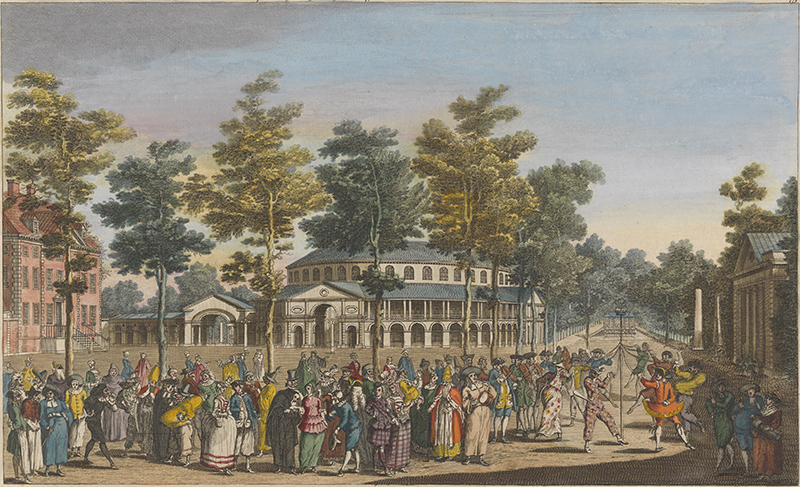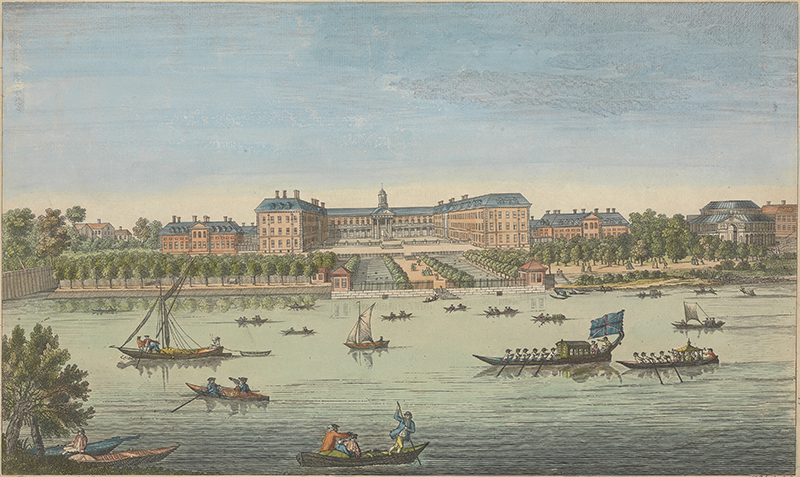Ranelagh Gardens
Paul F. Rice, Memorial University of Newfoundland
November 2022
When the Ranelagh Gardens opened in 1742, they were a comparative latecomer to the pleasure gardens of London. Located immediately adjacent to the Chelsea Hospital, access to the gardens could be made by road or, preferably, by boat on the Thames to the Ranelagh Stairs. From the outset, Ranelagh was designed to contrast with existing pleasures gardens, especially those of Vauxhall and Marylebone. While those locations featured nightly concerts in an out-of-door setting, Ranelagh boasted a large circular building to protect its patrons from the elements. It was open on Monday, Wednesday and Friday evenings, and all were admitted who were appropriately dressed and could afford the admission fee. Ranelagh managed to restrict the poorer elements of society by charging the steep entrance fee of two shillings and sixpence (half a crown), more than double what was charged at Vauxhall. Human nature being what it is, the suggestion of exclusivity likely made the location even more attractive for those of the non-aristocratic classes.
In the late years of the seventeenth century, Richard, 1st Earl of Ranelagh (1641–1712), had built Ranelagh House next to the grounds of the Chesea Hospital and caused fine gardens to be laid out, which attracted much favourable attention. The property was sold in 1733 to a consortium led by James Lacey of the Theatre Royal, Drury Lane, whose aim it was to transform the grounds into a public pleasure garden. The opening was delayed until 5 April 1742 when the Rotunda, the most prominent feature of enterprise, was unveiled.
 An Inside View of the Rotundo in Ranelagh Gardens, by Nathaniel Parr (active 1742–1751), after Canaletto. Yale Center for British Art, Paul Mellon Collection, B1977.14.17973. Public Domain. |
Warwick Wroth records that the large, domed building had an internal diameter of 150 feet. In the centre of the structure, a column not only provided support for the roof, but also housed a fireplace. As a heated facility, Ranelagh often remained open for longer periods than the other pleasure gardens since it was unaffected by inclement weather. “In the interior was a circle of fifty-two boxes, separated by wainscoting ... in each seven or eight people could be accommodated with refreshments” (Wroth, The London Pleasure Gardens of the Eighteenth Century, 1896). The print made by Nathaniel Parr, after the famous painting by Caneletto shows these boxes as well as the windows at the top of the structure that illuminated it during the day. A pipe organ was mounted against the exterior wall, below which orchestral musicians were grouped.
Refreshments consisted of complimentary tea, coffee, and bread and butter. No other refreshments were on offer, except at balls when the entrance fee was often quadrupled. The aristocracy was quick to patronize the new enterprise. Horace Walpole remarked in a letter to Henry Seymour Conway (29 June 1744) that Ranelagh “has totally beat Vauxhall ... the floor is all of beaten princes―that you can’t set your foot without treading on a Prince of Wales or Duke of Cumberland.” Walpole’s subsequent comment that the “company is universal: there is from his Grace of Grafton down to children out of the Foundling Hospital―from my Lady Townshend to the kitten―from my Lord Sandys to your humble cousin,” was likely meant to be ironic. It is highly unlikely that children out of the Foundling Hospital could have afforded the half crown admission fee.
Not all visitors were equally pleased by the delights of Ranelagh. Fanny Burney caused her heroine Evelina to describe Ranelagh as a “dull place” (Evelina, or the History of a Young Lady's Entrance into the World, 1778). Tobias Smollett caused the characters of Lydia Melford and Matthew Bramble to have divergent reactions in the novel The Expedition of Humphry Clinker. Miss Melfort experiences Ranelagh for the first time, describing it as “the inchanted [sic] palace of a genie, adorned with the most exquisite performances of painting, carving, and gilding, enlightened with a thousand golden lamps, that emulate noon-day sun; crowded with the great, rich, the gay, the happy, and the fair; glittering with cloth of gold and silver, lace, embroidery, and precious stones.” The more cynical Matthew Bramble questioned, “What are the amusements at Ranelagh? One half of the company are following one another’s tails, in an eternal circle, like so many blind asses in an olive-mill, where they can neither discourse, distinguish, nor be distinguished; while the other half are drinking hot water, under the denomination of tea, till nine or ten o’clock at night, to keep them awake for the rest of the evening” (The Expedition of Humphry Clinker, 1771).
The Rotunda was not the only point of interest at Ranelagh. Outside, there were formal gardens with gravel walks, the long walk to the Thames, a water feature with a fountain, a canal, a Chinese Pagoda, and a Temple of Pan.
Advertisements for Ranelagh offer some information about the entertainments on offer. That found in the London Evening Post (9−11 April 1751) states:
|
At Ranelagh House, on Monday next, the 15th instant, will be A Concert of Musick, the Vocal Parts By Signora Frasi and Mr. Beard. The Music begins at Twelve o’Clock, Breakfasting as usual. |
This concert was meant to accompany a public breakfast, a pastime which did not continue at Ranelagh after the mid-1750s. The vocal performers were certainly of the front rank. Giulia Frasi (before 1730−after 1774) was an Italian soprano whose career was largely spent in London where she sang in Italian operas. She became a great favourite of Handel and she sang in all of his oratorios, save one. John Beard (1716−91) similarly was associated with Handel, singing in his Italian operas and his English oratorios. Typical of the period, the names of the performers were thought to be more important than the music that they sang.
Music played an integral role in the entertainments on offer. Horns welcomed patrons arriving at the Ranelagh Stairs, and wind instruments serenaded those who walked the gravelled paths of the exterior gardens. Inside the Rotunda, the more formal concerts featured mixed vocal and instrumental programmes, the first of which took place on 24 May 1742. Acoustically, the vast space with its high ceiling might not have been ideal for the performance of vocal music. Smollett’s Matthew Bramble was made to say that “as for the orchestra, the vocal music especially, it is well for the performers that they cannot be heard distinctly.”
The young Mozart performed at Ranelagh on 29 June 1764, when he was only eight years of age. The occasion was a gala concert in benefit of the Surrey Lying-in Hospital. The Public Advertiser (26 June 1764) lists music from Handel’s Acis and Galatea and his Alexander’s Feast to be performed, with “the celebrated and astonishing Master Mozart, lately arrived, a Child of 7 Years of Age, [who] will perform several fine select Pieces of his own Composition on the Harpsichord and on the Organ.” Decreasing the child’s age by a year likely made his accomplishments even more amazing.
Fuller advertisements of the concerts came only later in the century, often in conjunction with special events. On 24 June 1791, a benefit evening was presented for the transgender French diplomat and spy, the Chevalière d’Éon, who had escaped to London in much reduced circumstances. A handbill published to advertise the event lists the works to be played:
Act I |
|
|---|---|
| Overture: | [G.F.] Handel |
| Concerto: | [Charles] Avison |
| Song: | Mrs. Piele |
| Organ Concerto: | Mr. John Ashley |
| Song: | Signora [Theresa] Negri |
| Violin Concerto: | Master [Franz] Clement |
Act II |
|
| Overture: | Haydn |
| Cello Concerto: | Mr. C. Ashley |
| Song: | Mrs. Piele |
| Clarinet Concerto: | Mr. William Mahon |
| Song: | Signora Negri |
| [J.C.] Bach: | full Piece |
This would have been a very full programme of music, indeed. The violinist, Master Franz Clement, was only eleven years of age at the time of the concert. Young wunderkinder were always a drawing card at London concerts.
By 1791, however, the fortunes of Ranelagh were waning. Unlike Vauxhall, the directors of Ranelagh had not been able to keep up with the changing tastes of Londoners. The younger generation found Ranelagh to be stiff and staid, while Vauxhall’s atmosphere was more relaxed. Vauxhall offered more varied entertainments and the opportunity for encounters and assignations in its numerous walkways. Ranelagh’s days were soon over. The great Rotunda closed in 1803 and was demolished in 1805; the grounds were eventually purchased by the Chelsea Hospital.


